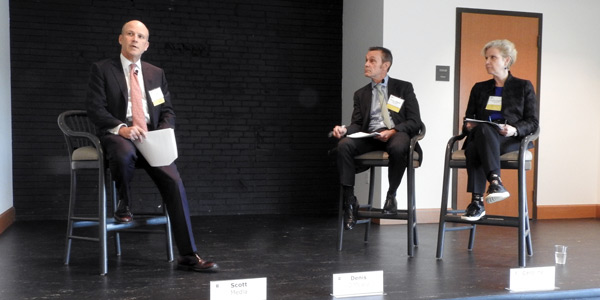By Michael Kuser
POUGHKEEPSIE, N.Y. — Capital markets this year are more willing than ever to finance green energy projects, said a panel at the Renewable Energy Conference last week.
“None of the terms have changed; the deals haven’t changed. What’s changed is banks’ appetite for renewables, and they’re willing to price down and move in on these deals,” said Denis O’Meara, managing director of energy and natural resources at BNP Paribas, who sat on a panel on renewable project financing.
The Business Council of New York State and the Hudson Renewable Energy Institute hosted the event at Marist College Wednesday.
“If you have a project and the project has merit, it’s going to get financed,” said panel moderator Scott Medla, managing partner at Ansonia Partners. “The institutional investors, the private equity guys, the banks — they have more money than they could possibly ever use to fund every project in America. The issue for them is finding the right project, the one that fits.”
Fringe Support

Caroline Angoorly sat on the panel as COO of the New York Green Bank, a billion-dollar fund supported by ratepayers and part of the state’s $5.3 billion Clean Energy Fund.
“The idea of New York Green Bank is to play in what we call that one standard deviation, on either side of where current energy project financing markets play,” Angoorly said. “As these new energy models get new traction [and] become more ubiquitous, [we] provide liquidity when traditional sources of capital may not be ready.”
Medla said that significant improvements in technology are helping drive banks’ interest in financing green projects.
“We’re seeing tremendous advances in creativity around transmission lines. We’re seeing wonderful things happen in the area of storage,” Medla said. “My view is that the lithium-ion batteries … are going to get surpassed pretty quickly with some of the creativity that I see out on the margin.”
Wind and Solar Financing

Wind projects in New York are more difficult to finance than in other parts of the country, according to O’Meara. “The reason is wind regimes and terrain, so you have to be very specific and you have to have very good wind studies to be able to build a wind turbine or wind farm here. … We’ll go up to 15 years in financing, maybe even longer depending on the [power purchase agreement]. … I’m telling you that because those are really pretty aggressive terms that we’re seeing out there in the market right now.”
Finance pricing now ranges between 1.35 and 1.75 percentage points more than the LIBOR, which O’Meara called attractive terms.
“The variable between the spreads really go to sponsor, technology, capital in, how much you’ve done — we’re going to look at all that when we make that determination of [if] we go ahead and finance,” O’Meara said.
BNP also does bond financing on wind, which tends to be a bit more lenient in its terms.
“You get a longer tenor [loan term] — sometimes less debt — but longer tenor, so you can put the deal to bed,” O’Meara said. “Solar’s more predictable: You know what it’s going to be on each season, and it works out more easily for us to think through a solar financing. Banks will go pretty long on solar as well, construction plus 18 or 20 years.”
Community Power
Angoorly cited the Green Bank’s $600 million pipeline of coming projects, including storage and microgrids, the latter supported by “a lot of pent-up demand for community-aggregated generation.”
O’Meara said he had similar experience with what is called community choice aggregation in California.
“In Marin County, they wanted to do this,” he said. “It’s a very good idea but really hard to bank at this point. … It’s not standardized. Many times I would call it the commune of power, because these people are putting these deals together and I have no idea what they’re saying. … I don’t know where they wrote it — probably in a coffee house — but it did not make sense.”
But fuzzy contracts haven’t stopped projects from moving forward.
“In fact, they’re getting the off-takers and the off-takers want to finance this,” O’Meara said. “It’s an evolving market. I guarantee you it will move into a more commercial purview shortly, but it’s not there now.”





